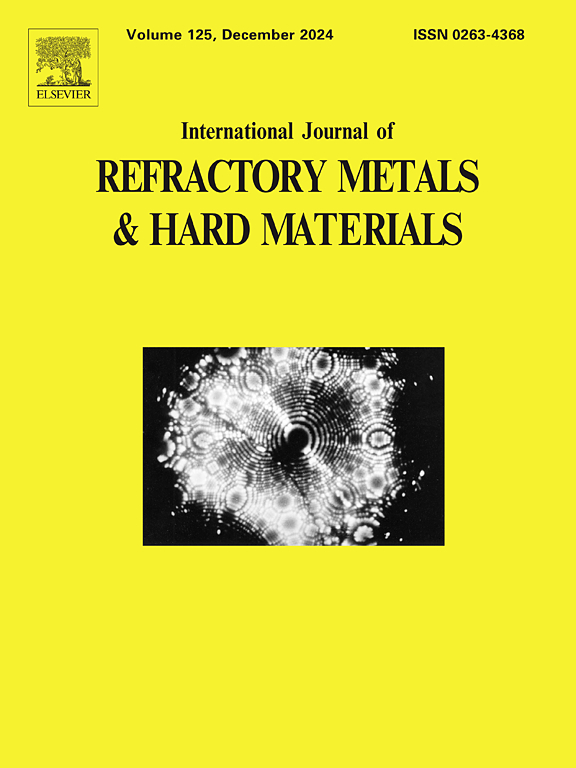h-BN氮源制备表面无立方相梯度硬质合金
IF 4.2
2区 材料科学
Q2 MATERIALS SCIENCE, MULTIDISCIPLINARY
International Journal of Refractory Metals & Hard Materials
Pub Date : 2025-03-25
DOI:10.1016/j.ijrmhm.2025.107120
引用次数: 0
摘要
本研究研究了具有立方无相表面层(CFL)的梯度硬质合金,它通常用作涂层刀片的衬底,以延长其使用寿命。坚韧的梯度表面层有效地防止裂纹扩展,最大限度地减少涂层分层和边缘剥落。本文提出用六方氮化硼(h-BN)作为非立方氮源制备立方(W,Ti)C梯度硬质合金,替代传统立方氮源。利用粉末冶金技术,我们成功地用h-BN衍生的CFL制备了梯度硬质合金。我们还分析了梯度结构形成的机理,表征了新材料的微观结构、元素分布和力学性能。结果表明,以氢氮化硼为氮源,用CFL制备梯度硬质合金是可行的。梯度边界处的晶体取向是随机分布的,表面与内部之间没有突然的界面。值得注意的是,钛(Ti)和硼(B)在表层几乎不存在,而钴(Co)的浓度高于内部。与传统立方TiN作为氮源时形成的聚类相比,h-BN的使用促进了钛在地下区域的均匀分布。此外,通过调节h-BN含量可以有效地控制梯度面层的厚度,随着原料中h-BN含量的增加而增加。然而,过量的h-BN添加促进了硬质合金中WC相的异常生长,尽管立方无相层有增韧作用,但对硬质合金的横向断裂强度有负面影响。h-BN含量的增加也促进了TiB相的形成,从而提高了硬质合金的硬度。本文章由计算机程序翻译,如有差异,请以英文原文为准。
Development of gradient cemented carbides with surface layers free of cubic phase via h-BN nitrogen source
This study investigates gradient cemented carbide with a cubic phase-free surface layer (CFL), commonly used as substrates for coated inserts to extend their service life. The tough gradient surface layer effectively prevents crack propagation, minimizing coating delamination and edge chipping. We propose using hexagonal boron nitride (h-BN) as a non-cubic nitrogen source for fabricating gradient cemented carbide with cubic (W,Ti)C, as a replacement for traditional cubic nitrogen sources. By employing powder metallurgy, we successfully created gradient cemented carbide with a CFL derived from h-BN. We also analyze the mechanism of gradient structure formation and characterize the microstructure, elemental distribution, and mechanical properties of the novel materials. The results demonstrate the feasibility of producing gradient cemented carbides with a CFL when h-BN is used as the nitrogen source. The crystal orientations at the gradient boundary are randomly distributed, showing no abrupt interface between the surface layer and the interior. Notably, titanium (Ti) and boron (B) are nearly absent in the surface layer, while cobalt (Co) shows higher concentration compared to the interior. The use of h-BN facilitates a nearly homogeneous titanium distribution in the subsurface zone, contrasting with the clustering seen when traditional cubic TiN is employed as the nitrogen source. Additionally, the thickness of the gradient surface layer can be effectively controlled by adjusting the h-BN levels, increasing with higher h-BN content in the raw materials. However, excessive h-BN addition facilitates abnormal WC phase growth in cemented carbides, and negatively affects transverse rupture strength despite the toughening effects of the cubic phase-free layer. Increased h-BN content also promotes the formation of TiB phases, which enhances the hardness of the cemented carbide.
求助全文
通过发布文献求助,成功后即可免费获取论文全文。
去求助
来源期刊
CiteScore
7.00
自引率
13.90%
发文量
236
审稿时长
35 days
期刊介绍:
The International Journal of Refractory Metals and Hard Materials (IJRMHM) publishes original research articles concerned with all aspects of refractory metals and hard materials. Refractory metals are defined as metals with melting points higher than 1800 °C. These are tungsten, molybdenum, chromium, tantalum, niobium, hafnium, and rhenium, as well as many compounds and alloys based thereupon. Hard materials that are included in the scope of this journal are defined as materials with hardness values higher than 1000 kg/mm2, primarily intended for applications as manufacturing tools or wear resistant components in mechanical systems. Thus they encompass carbides, nitrides and borides of metals, and related compounds. A special focus of this journal is put on the family of hardmetals, which is also known as cemented tungsten carbide, and cermets which are based on titanium carbide and carbonitrides with or without a metal binder. Ceramics and superhard materials including diamond and cubic boron nitride may also be accepted provided the subject material is presented as hard materials as defined above.

 求助内容:
求助内容: 应助结果提醒方式:
应助结果提醒方式:


